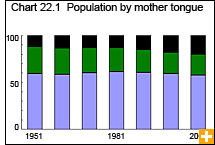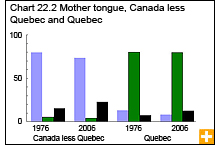Common menu bar links
Languages
Archived Content
Information identified as archived is provided for reference, research or recordkeeping purposes. It is not subject to the Government of Canada Web Standards and has not been altered or updated since it was archived. Please contact us to request a format other than those available.
In 2006, 18.1 million Canadians, or 58% of the population, reported English as their mother tongue, a drop from 61% in 1981. Another 6.9 million, or 22% of Canadians, reported French as the language they first learned and still understand, a fall from 26% in 1981.
Allophones—those whose mother tongue is neither English nor French— numbered 6.3 million in 2006. Partly as a result of sustained immigration from around the world, the proportion of allophones increased substantially to 20% of Canadians from 13% in 1981. Of the 1.1 million immigrants who settled in Canada from 2001 to 2006, more than 80%—901,300 people—were allophones.
The linguistic portrait has also shifted because francophones are having fewer children than in the past and some francophones outside Quebec have transferred to English and are less likely to pass on the French language to their children. However, in 2006 for the first time, the majority of Quebec allophones adopted French as their main home language when using an official language most often at home.
Over 200 languages reported
Canadians reported more than 200 languages as mother tongues in the 2006 Census. These include languages associated with traditional immigration, such as German, Italian, Ukrainian and Dutch, and languages that characterize more recent immigration, particularly those spoken in Asia and Latin America, which showed the largest gains.
Chinese languages are the third largest mother-tongue group: 3% of the population reported a Chinese language as the first language learned and still understood in 2006.
Among the three largest census metropolitan areas (CMAs), Toronto has the highest proportion of allophones. More than 4 residents in 10 have a mother tongue other than English or French. Chinese makes up the largest portion, followed by Italian and Punjabi.
Similarly, 4 out of 10 residents of Vancouver are also allophones. Chinese is the most frequent followed by Punjabi and Tagalog.
The Montréal CMA has proportionally fewer allophones at 22%. Italian heads the list followed by Arabic and Spanish.
The 2006 Census found that 98% of the population can speak one or both official languages and that English or French is spoken ‘at least regularly’ at home by 94% of Canadians. As well, English or French is spoken ‘most often’ at home by 89% of the population, sometimes in combination with a non-official language.
About one out of every two allophones (46%) speaks English or French most often at home. The proportion rises to 68% when including allophones who speak a language other than English or French most often at home but use English or French on a regular basis as well. Two out of five allophones speak English or French exclusively at home.
The longer allophone immigrants have resided in the country, the more they are exposed to the predominant language of the host society. This tends to affect the language spoken most often at home.
The proportion of allophone immigrants speaking an official language at home was 34% for those who arrived in the 1980s and 46% for those who arrived from 1961 to 1970.




